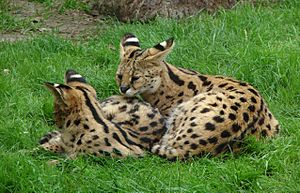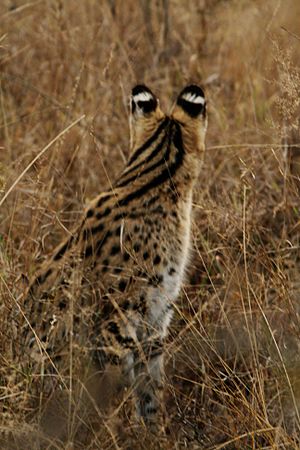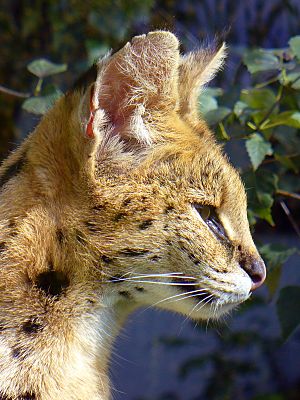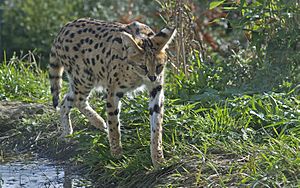Serval facts for kids
Quick facts for kids Serval |
|
|---|---|
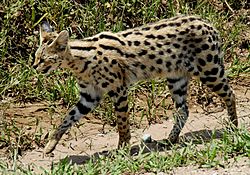 |
|
| In the Serengeti National Park, Tanzania | |
| Conservation status | |
| Scientific classification | |
| Kingdom: | |
| Phylum: | |
| Class: | |
| Order: | |
| Family: | |
| Genus: |
Leptailurus
|
| Species: |
Leptailurus serval
|
The serval is a wild cat that lives in Africa. It is not very common in North Africa and the Sahel area. But you can find many servals in countries south of the Sahara Desert, except in rainforests. The IUCN Red List says the serval is a species of "Least Concern." This means it is not currently in danger of disappearing.
Contents
Serval Appearance
The serval has the longest legs of all cats, compared to its body size. It can run very fast. It is also an amazing jumper. It can leap two to three meters (about 7 to 10 feet) high from a standing start!
An adult serval's body is about 81 centimeters (32 inches) long. Its tail adds another 41 centimeters (16 inches). It weighs around 1.8 kilograms (4 pounds). There are different types of servals, called subspecies. They live from the Cape of South Africa all the way to Algeria. They live wherever the environment is right for them.
Servals are lightly built. They have very large ears and long legs. The back of their ears is black with a big white spot. The tip of their tail is also black. These markings act like signals to other servals, including their kittens.
Serval Behaviour
Like most cats, the serval is a solitary animal. This means it lives alone. Servals are active during the day and at night. They might be most active in the early morning, around sunset, and at midnight. On cool or rainy days, servals might stay active for longer. During the hot middle of the day, they rest or groom themselves. They usually do this in the shade of bushes and tall grasses.
Servals are always careful about what is around them. They walk about 2 to 4 kilometers (1.2 to 2.5 miles) every night. Servals often use special trails to reach their hunting areas. Since they are solitary, servals do not interact much with each other. The only time they do is during mating season. The strongest bond is between a mother and her cubs. The cubs stay with their mother until they are about one year old.
Female servals protect their home areas. These areas are about 9.5 to 19.8 square kilometers (3.7 to 7.6 square miles) in size. The size depends on how much prey is available nearby. Male servals protect larger areas. Their territories are about 11.6 to 31.5 square kilometers (4.5 to 12.2 square miles). Males mark their territory by spraying urine onto bushes.
Servals can be hunted by hyaenas and wild dogs. If a serval sees a predator, it will try to hide. If the predator is very close, the serval will quickly run away. It makes long leaps and changes direction often. Its tail is raised when it flees. Servals can climb trees well, but they do not do it often. One serval was seen climbing a tree over 9 meters (30 feet) high to escape dogs. Like many cats, the serval can purr. It also makes a high-pitched chirp. It can hiss, cackle, growl, grunt, and meow.
Serval Habitat
In North Africa, servals are only found in Morocco. They have been brought back to Tunisia. However, they are thought to be gone from Algeria. Servals live in areas that are semi-dry. They also live in cork oak forests near the Mediterranean Sea. They avoid rainforests and very dry areas. You can find them in the Sahel region. They are also common in Southern Africa.
Servals prefer areas with good cover, like reeds and tall grasses. They like to be near water, such as wetlands and savannahs. They live in grasslands, moorlands, and bamboo thickets. They can even live at high altitudes, up to 3,800 meters (12,500 feet) on Mount Kilimanjaro.
Serval Diet
The serval is a nocturnal animal. This means it hunts mostly at night. The serval is an opportunistic predator. This means it eats whatever prey it can find. Its diet includes rodents, hares, hyraxes, birds, reptiles, insects, fish, and frogs.
Servals have special features that help them hunt in the savannas. Their long legs help them reach a top speed of 80 kilometers per hour (50 mph). They also have large ears with excellent hearing. Their long legs and neck allow them to see over tall grasses. Their ears help them find prey, even animals digging underground.
Servals are known to dig into burrows to find prey underground. They can also leap 2 to 3 meters (7 to 10 feet) into the air to catch birds flying by. Using its amazing jumping ability, the serval leaps up and bats the bird with its front paws. Once the bird is on the ground, the serval bites its neck to kill it.
Serval Reproduction and Life Cycle
A female serval is pregnant for two to three months. After this, she gives birth to one to four kittens. Births happen in hidden places. These can be in thick plants or in burrows left by other animals like aardvarks or porcupines. Newborn kittens are blind. They weigh about 250 grams (9 ounces). They have soft, woolly hair that is grayer than adult fur. Their markings are not very clear at birth.
The kittens' eyes open after nine to thirteen days. They start to eat solid food after about one month. The mother brings small animals she has killed to her kittens. She calls out to them as she gets close to their "den." A mother with young kittens rests less often. She also has to spend almost twice as much time and energy hunting than other servals.
If something disturbs the mother, she will move her kittens one by one. She takes them to a safer place. Kittens eventually start to go with their mother on hunts. Around six months of age, they get their permanent canine teeth. This is when they start to hunt by themselves. The mother will chase her male offspring away when they can hunt. This happens when they are about 8 to 10 months old. But she lets female kittens stay with her a little longer, up to a year. Servals can start having their own babies when they are 12 to 25 months old.
Servals usually live for about 10 years in the wild. In zoos, they can live up to 20 years.
Threats to Servals
A big danger to servals is the destruction of wetlands and grasslands. People used to trade serval skins a lot. This trade is now less common, but it still happens in countries like Benin and Senegal. In western Africa, servals are important in traditional medicine. Farmers sometimes kill servals to protect their animals. However, servals usually do not hunt farm animals.
Servals live in several protected areas across Africa. Hunting servals is not allowed in many of these places.
Servals in Culture
People have been connected to servals since the time of Ancient Egypt. Servals are shown in Egyptian art. They appear as gifts or items traded from Nubia. Like many other types of cats, servals are sometimes kept as pets. But because they are wild animals, owning servals is controlled by laws in most countries.
Serval Hybrids
On April 7, 1986, a healthy baby hybrid cat was born. It was a mix of a male serval and a female domestic cat. This kitten was bigger than a normal domestic kitten. Its fur pattern looked like its serval father. It seemed to have inherited some calm traits from its domestic mother. This hybrid cat might follow its owner around like a dog. It can also be a good swimmer. Over the years, the savannah cat has become popular as a pet. The savannah cat is a hybrid between a domestic cat and a serval.
Images for kids
-
A captive serval in Auckland Zoo
See also
 In Spanish: Serval para niños
In Spanish: Serval para niños



